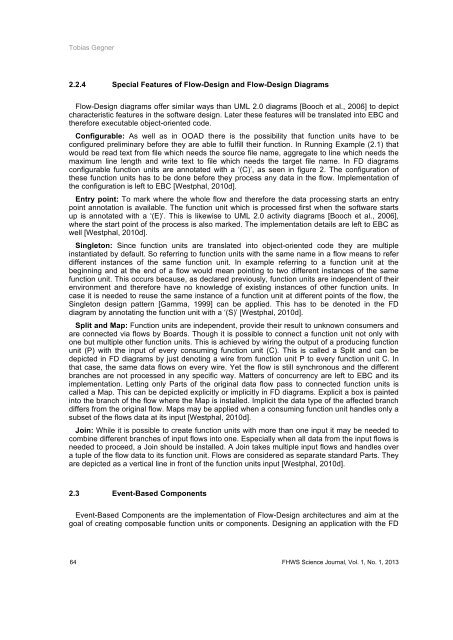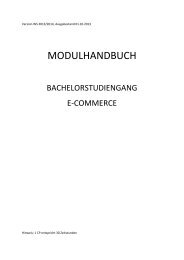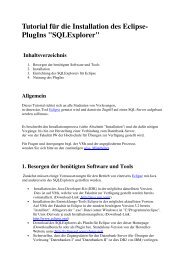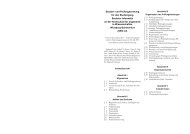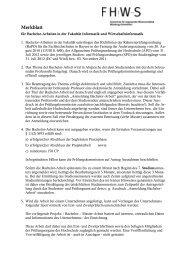FHWS Science Journal - Fakultät Informatik und Wirtschaftsinformatik
FHWS Science Journal - Fakultät Informatik und Wirtschaftsinformatik
FHWS Science Journal - Fakultät Informatik und Wirtschaftsinformatik
You also want an ePaper? Increase the reach of your titles
YUMPU automatically turns print PDFs into web optimized ePapers that Google loves.
Tobias Gegner<br />
2.2.4 Special Features of Flow-Design and Flow-Design Diagrams<br />
Flow-Design diagrams offer similar ways than UML 2.0 diagrams [Booch et al., 2006] to depict<br />
characteristic features in the software design. Later these features will be translated into EBC and<br />
therefore executable object-oriented code.<br />
Configurable: As well as in OOAD there is the possibility that function units have to be<br />
configured preliminary before they are able to fulfill their function. In Running Example (2.1) that<br />
would be read text from file which needs the source file name, aggregate to line which needs the<br />
maximum line length and write text to file which needs the target file name. In FD diagrams<br />
configurable function units are annotated with a ‘(C)’, as seen in figure 2. The configuration of<br />
these function units has to be done before they process any data in the flow. Implementation of<br />
the configuration is left to EBC [Westphal, 2010d].<br />
Entry point: To mark where the whole flow and therefore the data processing starts an entry<br />
point annotation is available. The function unit which is processed first when the software starts<br />
up is annotated with a ‘(E)’. This is likewise to UML 2.0 activity diagrams [Booch et al., 2006],<br />
where the start point of the process is also marked. The implementation details are left to EBC as<br />
well [Westphal, 2010d].<br />
Singleton: Since function units are translated into object-oriented code they are multiple<br />
instantiated by default. So referring to function units with the same name in a flow means to refer<br />
different instances of the same function unit. In example referring to a function unit at the<br />
beginning and at the end of a flow would mean pointing to two different instances of the same<br />
function unit. This occurs because, as declared previously, function units are independent of their<br />
environment and therefore have no knowledge of existing instances of other function units. In<br />
case it is needed to reuse the same instance of a function unit at different points of the flow, the<br />
Singleton design pattern [Gamma, 1999] can be applied. This has to be denoted in the FD<br />
diagram by annotating the function unit with a ‘(S)’ [Westphal, 2010d].<br />
Split and Map: Function units are independent, provide their result to unknown consumers and<br />
are connected via flows by Boards. Though it is possible to connect a function unit not only with<br />
one but multiple other function units. This is achieved by wiring the output of a producing function<br />
unit (P) with the input of every consuming function unit (C). This is called a Split and can be<br />
depicted in FD diagrams by just denoting a wire from function unit P to every function unit C. In<br />
that case, the same data flows on every wire. Yet the flow is still synchronous and the different<br />
branches are not processed in any specific way. Matters of concurrency are left to EBC and its<br />
implementation. Letting only Parts of the original data flow pass to connected function units is<br />
called a Map. This can be depicted explicitly or implicitly in FD diagrams. Explicit a box is painted<br />
into the branch of the flow where the Map is installed. Implicit the data type of the affected branch<br />
differs from the original flow. Maps may be applied when a consuming function unit handles only a<br />
subset of the flows data at its input [Westphal, 2010d].<br />
Join: While it is possible to create function units with more than one input it may be needed to<br />
combine different branches of input flows into one. Especially when all data from the input flows is<br />
needed to proceed, a Join should be installed. A Join takes multiple input flows and handles over<br />
a tuple of the flow data to its function unit. Flows are considered as separate standard Parts. They<br />
are depicted as a vertical line in front of the function units input [Westphal, 2010d].<br />
2.3 Event-Based Components<br />
Event-Based Components are the implementation of Flow-Design architectures and aim at the<br />
goal of creating composable function units or components. Designing an application with the FD<br />
64 <strong>FHWS</strong> <strong>Science</strong> <strong>Journal</strong>, Vol. 1, No. 1, 2013


